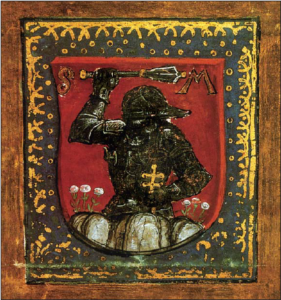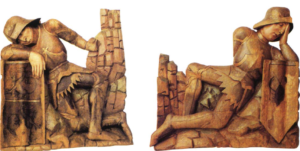The Doom of the Black Army after 1490

“Dead is Matthias, justice is gone” This Hungarian proverb was born after the great ruler’s death, in 1490. What has become of his once-famous standing army, the first of its kind in Europe? King Matthias of Hungary died on 6 April 1490 in Vienna. His succession had not been settled and thus his sudden death has caused confusion. Matthias had been granting titles and lands to his illegitimate son, Corvin János for years already and he had many of the barons of the country sworn fealty to his son, too. Yet, he could not have been sure whether the young prince would be strong enough to seize the crown.
You can read a series of articles I wrote about King Matthias here:
https://www.hungarianottomanwars.com/essays/king-matthias-corvinus-1443-1490/
After Matthias’ death, most of the high lords abandoned the 17-year-old boy. Even those of them did so who could have thanked their quick career to Matthias, like Kinizsi Pál or Báthori István, the Voivode of Transylvania. Queen Beatrix, the widow of Matthias was particularly hostile to the boy because she was aspiring for the crown, too. Let us not forget that allegedly she had a hand in poisoning the king.

Fortunately, Corvin János also had some powerful supporters like Prince Újlaki Lőrinc and the Archbishop of Kalocsa, Váradi Péter as well as the Bishop of Pécs called Ernuszt Zsigmond and Beriszló Bertalan. Yet, his party didn’t prove to be strong enough against the foreign usurpers who wanted to seize the Hungarian throne. Maximilian, the King of Rome was the son of the German-Roman Emperor Frederick III and he claimed the throne according to the Treaty of 1463. King Matthias had signed that contract because it was the condition to get the Hungarian Holy Crown back from the Emperor’s hand. The Treaty ruled that the Habsburgs would get the Kingdom of Hungary if he died without a legal heir.

Other applicants were the Bohemian King Ulászló and his younger brother, the Polish Prince János Albert who became the Polish king later. Prince Corvin János didn’t have a high chance against these powerful adversaries. The Hungarian Estates came together on a Diet to elect a king on 17 May whereas they cruelly deceived Prince Corvin János and made him sign a contract in which he resigned his claims for the Hungarian throne in exchange for the titles of the Bosnian Kingdom and the Croatian-Slavonian Dukedom.

The Battle of Csontmező (Bone Field)
Corvin János had to cede several important castles as well and as a result of this, he lost much of his power. However, when his supporters appeared with their armies a couple of days later, Corvin János changed his mind and declared the contract invalid. Then, he fled to the south, with the armies of the Polish Ulászló (Władysław II Jagiellończyk) party at his heels. The Prince was intending to gather his forces, in the meantime. Also, he took the Holy Crown of Hungary with him, along with a considerable part of the treasury from the royal palace. He had about 7,000 soldiers with him and his pursuers, Kinizsi and Báthory had roughly the same army but they were additionally supported by the heavy cavalry of Queen Beatrix.

They caught up with the Prince on 4 July 1490 at the village of Szabaton in Tolna County and the two armies faced each other on a field called Csontmező (Bone-field). The soldiers were quite unwilling to fight against the Prince so Báthory had to give them a speech. He explained to them why this fight was so important but he could not persuade them very much. Finally, to limit the needless bloodshed, Báthory challenged the other army’s leader to a duel.

It was Báthory who was the winner of the duel but when he wanted to kill his enemy who was helplessly on the ground, his own soldiers stopped him. This incident triggered the battle that they had wished to prevent. The clash didn’t last for a long time because the vice-generals of Prince Corvinus all fell and their army got confused and began to flee. Lord Újlaki decided to take away the Prince from the lost battle. Seeing this, the rest of the army (mainly peasant soldiers) which was still fighting, began to run, too.

There were only about 60 dead bodies counted on the battlefield and the army of Kinizsi didn’t chase the runners, they let them run away. Instead of the chase, they began looting the treasures of the Prince. As Kinizsi’s men were members of the famous Black Army, it is assumed that the looting was necessary to get their missing payment. Hearing the news of the lost battle, Ráskay Balázs, the castellan of Buda castle (so far loyal to Corvin János) decided to cede Buda castle to the men of Báthory.
Prince Corvin and the remains of his beaten army took shelter in the southern counties. Before long, the envoys of the recently elected Jagellonian King Ulaszlo II arrived at the Prince and made peace with him. The support given by Prince Corvinus was needed badly for King Ulászló II because the new king was attacked by his younger brother, Maximilian. Prince Corvinus János ceded the Holy Crown to Ulászló and moreover, he was carrying it before him at the coronation ceremony.

After this, the Prince was commanding the southern defenses of the Kingdom as Duke of Croatia and Slavonia and Duke (Ban) of Bosnia and he proved to be a rather successful general. Let us recall that he was able to beat the Ottomans three times: in 1499 at Sebenico, in 1500 at Mostar, and at Jajca in 1501. He died quite early (1504) and it was why he could not follow the steps of his grandfather, Hunyadi János.
Many people mourned him because they hoped he could become the new hero against the Ottomans. I assume it was the reason for his early death. According to some gossip, he died after a lost battle in 1504 while fighting off a bigger Turkish raid but it was rather because his body was weakened by poison. The same hearsay said that Queen Beatrix and Lord Szapolyai (not to forget the poison of King Frederick) had been involved in the assassination of King Matthias. They may have had a hand in getting rid of the detested illegitimate son of King Matthias. Yet, I will never comprehend why Kinizsi and Báthori had broken their oath and sided with Queen Beatrix. Read more about the life of Corvin János on my page:
https://www.hungarianottomanwars.com/essays/prince-corvin-janos-son-of-king-matthias-1473-1504/

https://hungarianottomanwars.myspreadshop.com/all
Prince Corvin left behind three children: Erzsébet (1496-1508), Kristóf (1499-1505), and Mátyás (1504-1505). But who needed one more hero of the Hunyadi clan? He was nominated by the Hungarian smaller nobles party in 1503 as a candidate for the title of Palatine of Hungary which was the second rank after the king but Archbishop Bakócz Tamás undermined his efforts. (Yes, Bakócz, the one who wanted to become a Pope so badly, the one who triggered the peasant war in 1514.) The Prince is buried with his son in Lepoglava Monastery which he had turned into a fortified church, it is in Croatia.

King Ulászló II was thought to be a weak king which was very much to the liking of the oligarchs. Matthias’ empire and strength have slipped smoothly off his hands. He has painfully accumulated the annual 100,000 ducats to pay the Black Army which was led by General Haugwitz. The black mercenaries’ name derived from their attire and armor and it is thought that they were called Black Army only in a later period, recalling that they were dressed in black when they were mourning their beloved king’s death. However, I do not think so because they were depicted in black armor in several contemporary paintings.

After the death of Matthias, these renowned soldiers were able to beat the intruding troops of the usurper Austrian Maximilian who could get into the kingdom as far as Fehérvár. Later, they also stopped the armies of the Polish Prince János Albert who was aspiring for the throne as well. Then, they were sent to guard the southern frontier against the Turks but their pay began to decrease and they were starving. The Hungarian barons who supported the new king didn’t want him to spend on military expenses. All the money that Matthias had collected and spent on wars, now was being spent on building up a happy Renaissance kingdom, ignoring the Ottoman threat altogether.
When Kinizsi Pál took over the Black Army’s leadership, their pay had not been increased and the hunger forced them to loot the countryside. The Treasure could not pay and this was how the kingdom was disarming itself, in the throat of the Ottoman Empire. Finally, the king agreed to send Kinizsi to stop the plundering at all costs. He arrived in Szegednic-Halászfalu in late August 1492, where he dispersed the Black Army led by Haugwitz. The Black Army used to be the basis and the symbol of Matthias’ strong state and now it was Kinizsi himself, their previous leader who had to defeat and slaughter them in a two-day-long fierce battle.

Of the 8,000 members, 2,000 were able to escape to western Styria, where they continued to pillage the countryside. The prisoners were escorted to Buda, where the Black Army was officially disbanded and they were allowed to leave abroad under the condition never come back and claim their payment. They joined the forces already in Austria.

They confronted Count Georg Eynczinger on 7 May 1493, at Thaya, where they were all killed or captured and tortured to death. The last remaining mercenaries were integrated into local garrisons, such as the one in Nándorfehérvár (Belgrade) under the leadership of Balthasar Tettauer, brother of Wilhelm Tettauer. They were so frustrated about the financial status that they allied with Ottoman Mihaloglu Ali Bey to secretly hand over the fort to his sultan, Bajezid II. When their plan surfaced, Kinizsi intervened in May 1494 before their act could take place. He arrested the captain and his troops for treason and starved them to death. Soon, he got a stroke and died, too. Here is more about him:
https://www.hungarianottomanwars.com/essays/kinizsi-pal-general-of-king-matthias/

The conquests of Matthias Corvinus faded away without a fight: Lord Szapolyai (the grandfather of Szapolyai János who became our king after Mohács, 1526) withdrew all the Hungarian troops from Austria. Yet, the fame of the Black Army has never died. Wasn’t the grandfather of our greatest warrior, Thury György, fighting in the Black Army? The military traditions of King Matthias lived on, just like the old hook-guns of his age which were aplenty in the castles of the Borderland.
Dear Readers, I can only make this content available through small donations or by selling my books or T-shirts.
If you like my writings, please feel free to support me with a coffee here:
You can check out my books on Amazon or Draft2Digital, they are available in hardcover, paperback, or ebook:
https://www.amazon.com/dp/198020490X
or at https://books2read.com/b/boYd81


My work can also be followed and supported on Patreon: Become a Patron!http://Become a Patron!


